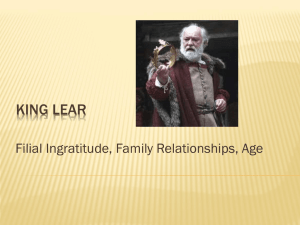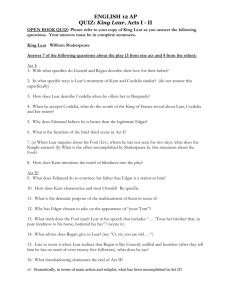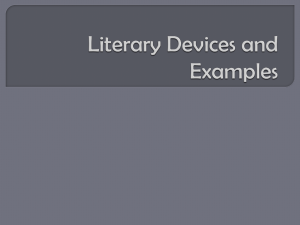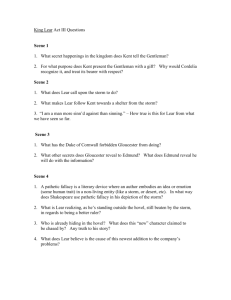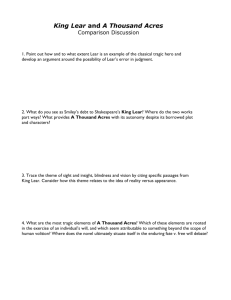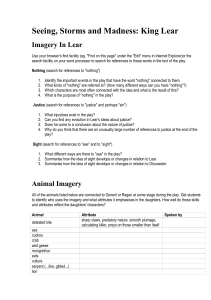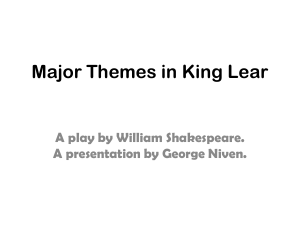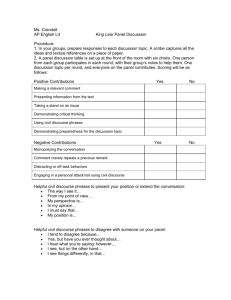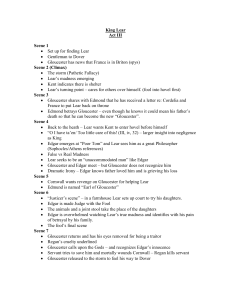King Lear Activity Pack
advertisement
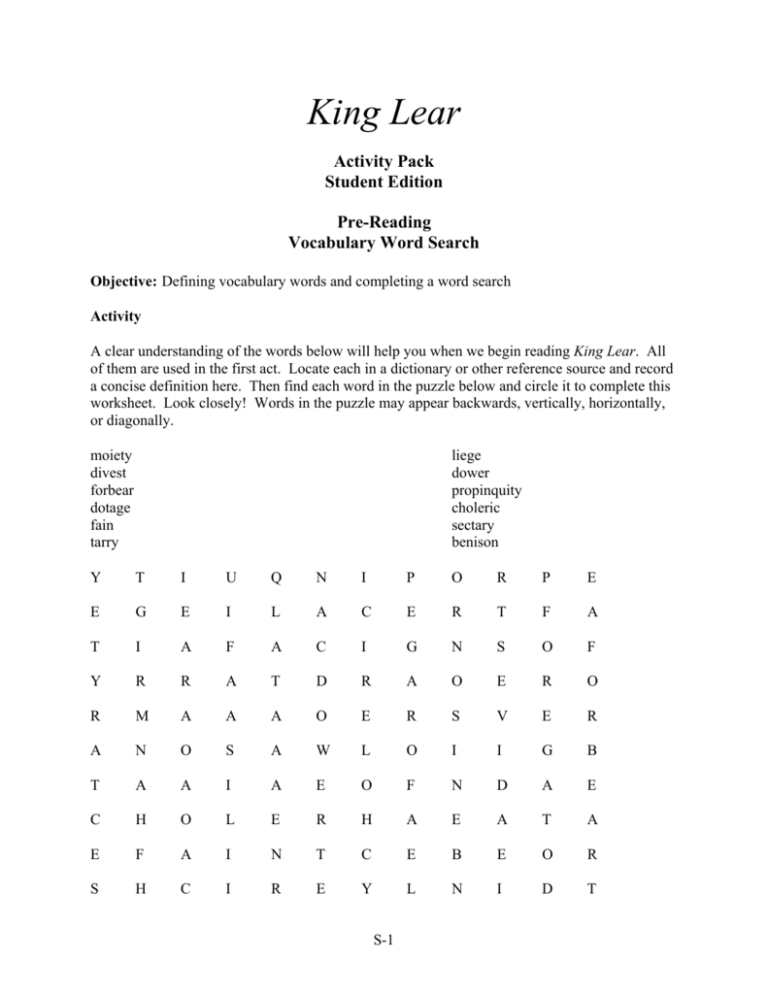
King Lear Activity Pack Student Edition Pre-Reading Vocabulary Word Search Objective: Defining vocabulary words and completing a word search Activity A clear understanding of the words below will help you when we begin reading King Lear. All of them are used in the first act. Locate each in a dictionary or other reference source and record a concise definition here. Then find each word in the puzzle below and circle it to complete this worksheet. Look closely! Words in the puzzle may appear backwards, vertically, horizontally, or diagonally. moiety divest forbear dotage fain tarry liege dower propinquity choleric sectary benison Y T I U Q N I P O R P E E G E I L A C E R T F A T I A F A C I G N S O F Y R R A T D R A O E R O R M A A A O E R S V E R A N O S A W L O I I G B T A A I A E O F N D A E C H O L E R H A E A T A E F A I N T C E B E O R S H C I R E Y L N I D T S-1 Pre-Reading Meter Objective: Understanding and writing in iambic pentameter Activity Most of King Lear is written in blank verse—that is, verse that does not rhyme. The songs of the Fool, which always rhyme, are one major exception. In addition, the verse of King Lear is mainly written in iambic pentameter. A line of iambic pentameter is made up of five “feet” (penta means “five”), each of which contains an iamb. An iamb is made up of two syllables, the first unstressed and the second stressed: daDUM. Examples of iambic words include intense (inTENSE), bizarre, contempt, and Michelle. When we read it aloud, a line of iambic pentameter has the following rhythm: daDUM daDUM daDUM daDUM daDUM. Read the below lines, from the first scene of King Lear, aloud, and listen to the rhythm. Come not between the dragon and his wrath. (Lear, Act I, Scene i) I find she names my very deed of love. (Regan, Act I, Scene i) Thy youngest daughter does not love thee least. (Kent, Act I, Scene i) I. Complete the chart below by deciding whether the listed words are iambs. If it helps, write each word out twice, each time putting a different syllable in capital letters: pretZEL PRETzel Read each version of the word aloud. Which sounds more like the correct pronunciation? In this case, PRETzel is correct. Our conclusion? “Pretzel” is not an iamb, because the first, not the second, syllable is stressed. S-2 IAMBIC WORD CHART Is it an iamb? (Yes or No) No WORD pretzel delight converge blackjack credit indeed daughter become II. Lines of iambic pentameter need not be made up entirely of two-syllable “iambic” words; in fact, they rarely are. Words that are not in and of themselves iambs can be used. Everything depends on whether the syllables next to each other are stressed or unstressed. For example, we have already decided that “pretzel” is not an iamb. “Pretzel” fits perfectly, though, in the below line of iambic pentameter. Read the line aloud, listening for the “daDUM daDUM” rhythm. This pretzel needs some mustard; pass the jar. If we were to capitalize the stressed syllables, the line would look like this: This PRETzel NEEDS some MUStard; PASS the JAR. The rhythm of the sentence is, indeed, daDUM daDUM daDUM daDUM daDUM. Read the following three lines aloud and decide if they are in iambic pentameter. Circle “yes” if a line is, and “no” if it is not. 1. I hear King Lear is Shakespeare’s masterpiece. YES 2. Thunder, rain, and trouble form the backdrop. YES 3. NO A man will lose his power, pride, and joy. YES III. NO NO Now, try your hand at writing your own lines of iambic pentameter. Two lines are provided for you below. Continue the “story” with two lines of your own. One Monday morning, I was eating toast and cramming for a science test that day, when... S-3 Pre-Reading Research and Presentations Objective: Researching and presenting background information Activity A little background information on both King Lear and the conventions of Shakespeare’s time will provide a good foundation to our study of the play. Each group will be assigned one of the below topics to research and educate the class about. You may use print sources or the Internet in your research. Presentations should be 5-7 minutes long. You are encouraged to make use of props, posters, or any other visual aids that will assist your audience in understanding your subject. On the day of your presentation, you must, as a group, turn in a one-page summary of what you have learned from your research. Pre-Reading Research Topics for King Lear: 1. Shakespeare crafted the plot of King Lear using bits and pieces of other works of literature. Research Shakespeare’s sources for King Lear, and tell us a bit about them. 2. Research the role of the Fool in Shakespearean drama. 3. In Shakespeare’s time, playwrights could not directly mention a reigning monarch in their plays. There is some speculation, however, that Shakespeare is poking fun at King James I in parts of King Lear. Research James I, including how he came to power, how he was popularly viewed, the length of his reign, and things that were accomplished under his reign. 4. Research the way in which Shakespeare’s plays were staged, the Globe Theatre, who comprised a typical audience, and how audiences generally behaved at the theatre. 5. Research the conventions of society in Elizabethan England. How were parents and the elderly expected to be treated? How much mixing went on between members of different economic classes? 6. Give us an overview of Shakespeare’s life, including pertinent dates, the conditions he lived in, and his reception by the public in his day. S-4 Acts I-V Characterization Objective: Keeping a character log on King Lear Activity As King Lear progresses, we learn more and more about Lear. We learn from other characters’ observations, Lear’s actions, and Lear’s own words. As you read, keep a character log on Lear. In the left column, note down any significant or interesting actions or speeches of Lear’s, as well as any insightful observations others make about Lear. In the right column, comment on what each entry in the left one tells you about Lear’s character. If you quote directly from the book, remember to record act and scene numbers along with your quotations. You must make a minimum of three log entries per act. One sample log entry (from Act I, scene i) is provided for you below. CHARACTER LOG FOR KING LEAR ACTION, SPEECH, or OBSERVATION Lear asks his daughters to publicly declare how much they love him in exchange for a piece of his kingdom, and believes that the daughter who flatters him the most must be the one who loves him the most. ACT #; SCENE # I, i S-5 WHAT IT SAYS ABOUT LEAR’S CHARACTER Lear likes to be flattered, but lacks insight into the nature of flattery. The motive behind flattery is usually self-interest; we flatter people to get what we want. Flattery is not a true indication of love or respect. What is said is not necessarily what is felt, but Lear does not recognize this. He is naïve. S-6 S-7 Acts I-V Headlines Objective: Writing newspaper headlines for each act Activity Journalists strive to make newspaper headlines both informative and intriguing. The idea is to create a balance between capturing the main issue of a story and compelling readers to continue on and read the entire article. Imagine that you are an undercover journalist for The Daily Eclipse, Ancient England’s premiere news source. A master in your field, you are so successfully sneaky that you manage to eavesdrop on every event and conversation that takes place in King Lear. It is in your best interest, of course, to come up with scandalous scoops that everyone will want to read. As you read King Lear, compose three newspaper headlines for each act. Remember that headlines are brief; yours should be no longer than eight words long. An example is provided below. ACT I Headline #1: FAVORITE DAUGHTER DOESN'T LOVE HIM, SHOCKED KING LEARNS Headline #2 Headline #3: ACT II Headline #1: Headline #2: Headline #3: ACT III Headline #1: Headline #2: Headline #3: ACT IV Headline #1: Headline #2: Headline #3: ACT V Headline #1: Headline #2: Headline #3: S-8 Acts I-IV Motif Objective: Tracking a motif throughout the play Activity References to sight, insight, and our ability to tell the difference surface repeatedly in King Lear. Tracking this thread will assist you in determining its significance, and reveal which characters it concerns the most. Record significant sight-related quotes on the below chart, taking note of the act and scene numbers as well as the lines' speakers. An example has been provided for you. SIGHT AND INSIGHT IN KING LEAR Quotation Act #; Scene # Speaker “See better, Lear, and let me still remain/The true blank of thine eye.” I, i Kent S-9 S-10 Act I, Scene ii Critical Thinking Objective: Thinking critically about social norms and laws Activity In his soliloquy at the beginning of this scene, Edmund sums up his anger at what he deems a social injustice: Thou, Nature, art my goddess. To thy law My services are bound. Wherefore should I Stand in the plague of custom, and permit The curiosity of nations to deprive me... ...Why bastard? wherefore base? When my dimensions are as well compact, My mind as generous, and my shape as true As honest madam's issue? Many of us have felt, at one time or another, the “plague of custom”—that is, resented a law or custom that inconveniences or deprives us and seems unfair. When he mentions the “curiosity of nations,” Edmund refers to the seemingly arbitrary (and “curious”) quirks of his country that deny him the same rights and respect his brother receives because, unlike Edgar, Edmund was born out of wedlock. Edmund protests that his body and mind are just as good as Edgar's; in other words, Nature has made them equals. Why, then, should society say they are not equal? Edmund promises to bind his services to Nature's law—and not to take society's law lying down. The custom in Edmund’s time was to condemn illegitimacy. In your group, come up with a list of no fewer than ten laws or customs of modern society that deprives a group of citizens of equal rights. You may include laws from the past as well as ones currently in place. Remember that minors—American citizens under age 18—also constitute a group. 1. 2. 3. 4. 5. 6. 7. 8. 9. 10. S-11 As a group, discuss the below questions and come to a unanimous answer on each. You will be sharing your answers with the rest of the class. 1. Is Edmund's anger justified? Explain your answer. 2. What do we get in exchange for agreeing to follow society's laws, whether we agree with the laws themselves or not? 3. Assume you disagree with one of society's laws and feel it unfairly limits your rights. Which of the following options seems the most rational way of handling your anger? Any answer can be correct; however, you must provide specific examples to back up your opinion. A. B. C. D. E. 4. staging a nonviolent protest voting for a political candidate who shares your beliefs ignoring the law, or finding some way to sneak past it working to become so exceptional that anyone who meets you will soon disagree with the law and call for its abolishment inciting a revolution and changing the law “by any means necessary” Consider the above choices again. Which seems the most effective and instantly gratifying way of handing your anger? S-12 Act I, Scene ii Creating a Scene Objective: Creating an additional scene to a play Activity Edmund is Gloucester’s illegitimate son, who plans a scheme to get rid of Edgar, Gloucester’s legitimate son, and heir to the earldom. Edmund creates a letter in Edgar’s name, betraying Gloucester. Edmund tells Edgar that somehow Gloucester has become offended by Edgar: “Bethink yourself wherin you may have offended him; and at my entreaty forbear his presence until some little time hath qualified the heat of his displeasure, which at this instant so rageth in him that with the mischief of your person it would scarcely allay.” Edgar knows evil is at work, but flees from the kingdom to avoid further confrontations. It is Edmund’s scheme that forces Edgar from the kingdom. I. Imagine Edmund begins feeling guilty for betraying his brother and father. Write a letter to Gloucester from Edmund confessing the details of his evil scheme. Write a response letter from Gloucester. Does the Earl forgive his bastard son? How does the Earl react? Dear Father, As of late I have been experiencing sleepless nights, overcome with the guilt of my actions. I have to confess… Dear Edmund, This news surprises me! It is hard to believe… II. After hearing that Edgar has fled from the kingdom, Gloucester becomes worried for his son. Create a poster in search of Edgar. Is a reward offered? Be sure to include all the information necessary for Edgar to be returned safely. Be creative! S-13 Acts I & II Apostrophe Objective: Recognizing apostrophe Activity Shakespeare uses apostrophe extensively in King Lear. Complete the chart by recording at least six examples of apostrophe from Acts I and II. Make sure to fill in the act and scene numbers for each. An example is provided for you. After your chart is complete, answer the question that follows. Example of Apostrophe Act #, Scene # Ingratitude, thou marble-hearted fiend, More hideous, when thou show'st thee in a child, Than the sea-monster.” Question: I, iv Look back over your chart. In general, what seems to be the tone of the lines containing apostrophe? Answer: S-14 Act I, Scene iv Critical Thinking Objective: Thinking critically about identity and aging Activity One of the first things adult strangers ask each other upon meeting is “What do you do?” As adults, we spend most of our waking hours at our jobs. What we do for a living becomes a core part of how we define and see ourselves. It is deemed so essential to our identity, in fact, that our jobs are usually the first thing revealed about us in our obituaries, after our names—even if we have been retired for many years: Ron Tarasovic, 40-yr Chief of Police, Dies at Age 86; Kathryn Randall, Minister, Dies at 79. As the play opens, Lear has just done the equivalent of retiring; he has divided his kingdom and royal duties between his two daughters and sons-in-law. What Lear fails to anticipate is that, once he is no longer in office, he might not be treated with the same deference and respect as he has been throughout his reign. He begins to experience just such a shift when he stays with Goneril and Albany. Consider and answer the following questions in brief. Be prepared to share your answers in a class discussion. S-15 1. When Oswald is rude to him, Lear asks, “O, you sir, come you hither, sir: who am I, sir?” Oswald answers, “My lady's father.” Lear is instantly enraged, and begins spitting curses at Oswald. What answer was Lear expecting to hear, if not “My lady's father”? 2. While most people look forward to retirement, research indicates that a surprisingly high number become clinically depressed upon retiring. Why do you think this might be? 3. At one point, Lear asks his fool, “Dost thou call me fool, boy?” The Fool replies, “All thy other titles thou hast given away.” What is the Fool reminding Lear of? How do we know that Lear needs to be reminded? 4. Consider what was discussed above: that, as adults, our jobs come to form the bulk of our identities. What relevance does this have to the below quote, spoken by Lear? Doth any here know me? This is not Lear: Doth Lear walk thus? speak thus? Where are his eyes? Either his notion weakens, his discernings Are lethargied—Ha! waking? 'tis not so. Who is it that can tell me who I am? 5. If you were directing a staged version of King Lear, what tone would you have the actor portraying Lear use to deliver the lines quoted in #4? Should Lear sound angry here? Baffled? Sad? Sarcastic? Some other way? There is no one right answer. Back up your decision with an explanation of why you chose as you did. S-16 Act I Characterization Objective: Recognizing character traits Activity When we first begin reading a play, it takes a bit of time before we can tell the characters apart and zone in on what makes them unique. For the most part, plays are meant to be watched, not read. If we were seeing a production of King Lear, everything from the actors' faces and costumes to their tones of voice would reveal something to us about who they are. As readers, we must intuit some of their character traits. Use the below Character Chart to organize your impressions of the characters from Act I. In the first column, list the characters' ranks or trades; in the second, sum up what we know of their personalities so far; in the third, list their concerns and/or goals, and in the fourth, choose wellknown contemporary actors that you might cast in their roles. Briefly describe why you think the actors you have chosen will be perfect for their parts. An example has been done for you. S-17 CHARACTER CHART for KING LEAR, ACT I Character Trade/Title Description of Personality Concerns and/or Goals Who I'd Cast in the Role and Why Cordelia princess, soon to be queen of France honest; unwilling to flatter just to get ahead; moral; brave enough to stand on her own has been disowned by her father Brittany Snow (“Meg” from “American Dreams”)—she looks innocent and honest, but can also pull off moral indignation (like Cordelia's at her sisters) Lear Edmund Goneril S-18 Kent Gloucester Fool Oswald S-19 Act II Motivation Objective: Understanding characters’ motivations Activity Is it possible to sympathize with Regan and Goneril? Can we imagine what has motivated their inhospitality to their father? From the sisters’ point of view, write a letter to “Anne of Landers,” an advice columnist, detailing the trouble you are having with your father, explaining your feelings on the matter, and asking for guidance. When you have finished writing the letter from Regan and Goneril, compose a response from Anne of Landers. Below is a sample beginning for the sisters’ letter. You may continue on from it, or write your own beginning and proceed from there. Dear Anne of Landers, Our elderly father, while generous, is beginning to tax our patience. A retired king, he insists on keeping a full retinue of rowdy knights with him. Moreover, he expects us to house them! What part of “retirement” does he not understand? What… S-20 Acts II-V Imagery Objective: Recognizing recurring imagery in King Lear Activity Throughout acts two through five, Regan and Goneril are repeatedly compared to animals by other characters. To complete the following chart, find at least five instances of animal imagery in reference to them and record these below. An example—from act one, incidentally—is provided. After you have finished, answer the question below the chart. S-21 ANIMAL IMAGERY IN KING LEAR Quotation “Detested kite, thou liest!” Question: Act #, Scene # I, iv Speaker Attributes of Animal Lear bird of prey—as such, associated with a greedy, lethal hunger and taking advantage of the weak In Act IV, Scene vi, Lear says of women, “Down from the waist they are Centaurs.” What does this suggest about his view of sexuality? Answer: S-22 Act II, Scene ii Diction Creative Writing Objective: Writing “Shakespearean” insults Activity There can be no doubt about it: Shakespeare's characters are experts at insulting one another. In this scene, which provides a bit of comic relief, Kent calls Oswald a “one-trunk-inheriting slave” and “filthy-worsted-stocking knave”. Then he offers to “tread [Oswald] into mortar, and daub the wall of a jakes with him”—in other words, to beat him to a pulp and paint an outhouse with him. These are far more creative put-downs than we generally hear in the halls. With your group, come up with biting Shakespearean insults that one might use in the following situations. Feel free to flip through your book for words and inspiration. All groups will share their insults with the class; then vote on whose are the most clever and authentic-sounding. S-23 1. 2. Situation: You are stuck on a one-lane road behind someone who insists on driving ten miles below the speed limit. You say... Example: “Thou tardy-gaited, idle-headed snail-wit!” Situation: You are forbidden from saying “Shut up!” and need a new way to phrase that sentiment. You say... Your insult: 3. Situation: You find out that your significant other is cheating on you...with three other people. You say... Your insult: 4. Situation: You catch a younger sibling in your room, rifling through your things. You say... Your insult: 5. Situation: Right now, you notice someone from another group trying to see the insults your group has written down in order to copy them or come up with something more over-the-top. You say: Your insult: S-24 Act III Dramatic Interpretation Objective: Understanding drama through performance Activity Plays such as King Lear are written for the stage. Reading a play without watching it sometimes omits elements that only a physical performance can introduce. With your group, select a single scene from Act III to act out for the class. Members of each group will assign themselves roles. If necessary, divide the scene to accommodate everyone; for example, two people might act the first half of a scene, two others the second half. Discuss your chosen scene and settle on the details that staging will require. Will you use props or sound effects? Where will each character stand? Will characters move around during the course of the scene? Will some characters speak more rapidly or loudly than others? In considering these and other questions, be sure to record the reasons behind your decisions. Why is your dramatic interpretation of your scene an apt one? How does your performance capture the essence of and accentuate the key issues in King Lear? Why would Shakespeare, if he could see it, appreciate the way you have staged the scene? Each group will write a one-page explanation of their staging decisions and the reasoning behind them, to be turned in after performing the scene for the class. S-25 Act III Symbolism Objective: Recognizing symbolism Activity Nature and natural settings often have symbolic value in Shakespeare’s work. In King Lear, our first taste of the natural world comes in the form of the stormy heath in Act III. What might this natural setting symbolize? Does it provide a contrast to life in town and at court? Does it embrace Lear? What does it suggest about human beings? With your group, discuss the symbolic value of the stormy heath and compose a paragraph that answers the above questions. When you are finished, groups will read their paragraphs to the class, to be used as a jumping-off point to discuss Lear’s symbolism further. S-26 Act III, Scene vi Mock Trial Objective: Writing a trial involving the characters in the play Activity In this scene King Lear creates a mock trial for his disloyal daughters. The trial is never completed. Elaborate on the trial Lear begins to create to prosecute Goneril and Regan. Goneril and Regan must testify in their own defense. Be sure to stay consistent with each character’s personality. This trial must have a judge, jury, and witnesses (all characters chosen from the play) to be successful. You may begin as follows: [Regan is called to take the stand, she is sworn in, and takes a seat next to the [judge]; it is the Fool who is acting as Lear’s lawyer] Fool: Regan, is it true you will not allow your own father to stay in your home with you? Regan: It is. Fool: What is your reasoning for this type of behavior? Regan: I believe… S-27 Acts III & IV Comprehension Objective: Understanding Shakespeare’s language Activity When we read a play in iambic pentameter, we often get so caught up in the rhythm of the lines that we sail by them too quickly to truly understand what is being said. It helps to go back and examine challenging passages one by one, “translating” the gist of them into more basic, easily comprehended terms. Review and translate the passages below with your group. You may need to find them in your text and read the lines that come before and after them. Your translations will be discussed in class; afterwards, each group must turn in one copy of their work. An example of a difficult passage from Act II and its translation are provided for you. Sample Passage: …O sir, to willful men, The injuries that they themselves procure Must be their schoolmasters. (Regan, Act II, scene iv) Sample Translation: Some people just have to learn things the hard way—by screwing up. Passage One: The art of our necessities is strange, That can make vile things precious. (Lear, Act III, scene ii) Translation One: Passage Two: …where the greater malady is fix’d, The lesser is scarce felt… …When the mind’s free, The body’s delicate. (Lear, Act III, scene iv) Translation Two: S-28 Passage Three: Who alone suffers suffers most i’ the mind, Leaving free things and happy shows behind; But then the mind much sufferance doth o’erskip, When grief hath mates, and bearing fellowship. (Edgar, Act III, scene vi) Translation Three: Passage Four: World, world, O world! But that thy strange mutations make us hate thee, Life would not yield to age. (Edgar, Act IV, scene i) Translation Four: Passage Five: …Had he been where he thought, By this had thought been past. (Edgar, Act IV, scene vi) Translation Five: S-29 Act IV Metaphor and Simile Objective: Understanding metaphor and simile Activity Act IV contains many instances of simile and metaphor. To complete the below chart, find and quote at least six examples. In the second column, record the number of the scene in which you find each example; in the third, explain the metaphor or simile, including a mention of the tone it sets. One is done for you as an example. METAPHOR OR SIMILE “As flies to wanton boys are we to th' gods: They kill us for their sport.” SCENE # i S-30 EXPLANATION compares human lives to the fleeting, insignificant lives of flies; suggests a casual, meaningless cruelty in the world Act IV Characterization Objective: Analyzing characters in the play Activity I. Psychologists are trained to examine patients, determine the sources of problems, and implement possible solutions. They use personal observations and facts gathered from the patient in making a diagnosis. You are now a modern psychologist, and below is a list of your patients for today. Write down your initial analysis for each patient and the possible source of the problem. In the TREATMENT column, suggest a treatment. Remember, characters may have multiple mental or emotional problems. NOTE: Unlike psychiatrists, psychologists cannot prescribe medication. Depression and anxiety disorders are diseases brought about by chemical imbalances, while the problems of the characters in King Lear result from their situations. For this reason, and out of respect for those with serious mental illnesses, please put “situational” in front of a diagnosis of depression or a similar disorder. An example is provided below. S-31 PATIENT 8:00 – Gloucester PROBLEM CAUSE situational depression; suicidal tendencies; guilt guilt over his unwitting cruelty to Edgar; Edmund’s deception; anxiety over Lear’s treatment; to a lesser extent, the loss of his eyes TREATMENT arrange reconciliation meeting with Edgar; counseling for depression 9:00 – Regan 10:00 – Edmund 11:00 – Goneril 1:00 – Lear 2:00 – Kent II. Choose one of your patients and compose a dialogue you might be likely to have with him or her in a therapy session. Include at least ten questions you would ask the patient and supply his or her potential answers. Use the format given below. Doctor: Tell me, Regan, how did you feel about Cordelia when you were children together? Regan: Well, it was obvious the little witch was Father’s favorite… (etc.) S-32 Acts I-IV Dialogue Objective: Writing dialogue Activity We often learn as much about characters from their conversations as we do from their actions. This activity will enable you to demonstrate your knowledge of King Lear’s characters and to exercise your imagination. Choose any three of the prompts that follow. For each, write at least a page of dialogue that might have occurred in the situation mentioned. Feel free to let the dialogue carry you beyond what you already know of the characters, but strive to represent them accurately. One of your three dialogues should be written in iambic pentameter; the other two may be written in prose or verse. 1. Write the conversation that might have taken place between Cordelia and France after they left Lear’s court—with Cordelia penniless, disowned, and poised to become Queen of France. (Act I, Scene i) 2. Write the conversation that might have ensued had the Fool seen past the banished Kent’s disguise and exposed Kent to Lear. (Act I, Scene iv) 3. Write the dialogue that might have taken place between Edgar and Gloucester had Gloucester taken the chance to speak directly to his first son before Edgar fled to the forest. (Act II, Scene i) 4. Write the conversation that might have taken place between Regan and Goneril if Regan had agreed to accommodate Lear and lodge his 100 knights as well. (Act II, Scene iv) 5. Before blinding Gloucester, Cornwall suggests that Edmund leave the room and take Goneril for company. Write the conversation that might have taken place between Goneril and Edmund once they were in private. Remember, it is just after this point in the play that we learn they have fallen in love. (Act III, Scene vii) 6. After his blinding, Gloucester calls out to Edmund. Suppose that Edmund hears him and comes into the room. Write the dialogue that might take place between Gloucester and Edmund at that point. (Act III, Scene vii) 7. Write the conversation that may take place if Goneril were to overhear Regan’s words to Oswald in Act IV, Scene v. 8. Cordelia’s conversation with Lear ends abruptly as the two leave the tent to go for a walk. Continue their conversation, writing the dialogue between the two of them as they walk around the French camp. (Act IV, Scene vi) S-33 Act IV, Scene i Scene Recreation Objective: Recreating a scene from a play from a different perspective Activity Gloucester is deeply distressed; he thinks death is the only way to save himself from the pain he is experiencing in life. It is Edgar who assists Gloucester to the edge of the cliffs. Why does Edgar never reveal himself to his father? If Edgar had revealed himself, do you think Gloucester would have rethought reverting to suicide? Recreate this scene. Gloucester is still considering suicide, but this time, Edgar identifies himself. Write the scene as a play, using the best Shakespearean language you can, describing the events as they unfold. You may include stage direction, but this is not necessary. • Is Gloucester happy that Edgar reveals himself, forgetting suicide? • Is the emotional distress Gloucester is experiencing too overwhelming to cope with? • What is Gloucester’s reaction to the information Edgar gives? • Is he angry with Edgar for not identifying himself sooner? • Does Gloucester go through with the suicide? S-34 Act V Language Objective: Understanding and working creatively with Shakespeare’s English Activity Below is a short scene written in contemporary language. Translate the scene into language that would make sense to the characters in King Lear or, for that matter, a Globe Theatre audience attending one of Shakespeare’s plays. The first few lines have been done as an example for you. S-35 TAKE ONE: Contemporary Version Scene: A shoe store. A boy begins walking steadily towards the entrance, wearing a pair of boots he intends to shoplift. A clerk spots him and yells to other customers for help. Clerk: Stop that kid! Ma’am, I’m begging you! He’s getting away with a pair of boots! Woman: [Grabbing boy by the shirt] I’ve got you, you rascal! Wait a minute…aren’t you my daughter’s date for prom? Manager: [Coming over to the clerk, as boy remains silent] That’s the fifth shoplifter you’ve caught in only a year. I’m going to give you a bonus for your watchfulness. [To thief] Come here, boy. Boy: [To woman] I was. I don’t suppose I am after this. [To manager] You’re not going to call my parents, are you? Manager: Can you give me a reason why I shouldn’t? Boy: Um…I was only planning to borrow the boots. I wanted to look good for the prom. I was going to slip them back into the store afterwards. Manager: So…you think I’m running a shoe library? Borrow, bring back, borrow again? Boy: Sir, I’m begging you. Manager: I’m still waiting for a good reason. Boy: I could work here. For free. For two months. That should make up for the cost of the boots. Manager: We’ll discuss that. But yes, that’s a deal. [To woman, still hanging around] Ma’am, can I help you? Woman: I just want to make sure the boy still wants to take my girl to the prom. Boy: You’d let me? Woman: Sure. She’s never had a boyfriend with a job before, and now you work in a shoe store. The End S-36 TAKE TWO: Shakespearean Version Scene: A shoemaker’s shop. A young boy begins walking steadily towards the entrance, wearing a pair of boots he intends to steal. The shoemaker’s apprentice spots the boy and yells to a customer to help. Clerk: Take hold of that youth! I prithee, Madame! He’s getting away with a pair of boots! Woman: [Grabbing boy by the shirt] I’ve caught thee out, knave! But, hold…are not thou he who is to escort my lass to the Spring Festival? Manager: [Coming over to clerk] ’Tis the fifth knave thou’st spied out in a mere twelvemonth… Boy: [To woman] [To manager] Manager: Boy: Manager: Boy: Manager: Boy: Manager: [To woman, still hanging around] Woman: Boy: Woman: THE END S-37 Act V Genre Writing Dramatic Performance Objective: Writing and performing Act V of King Lear in a television genre Activity: A love triangle, a poisoning, treason, death, and two secret identities revealed: the action in Act V would definitely make for “good TV”. In fact, it would work well in any of the below television program genres. Your assignment is to write and perform a 7-10 minute “screenplay” that covers at least three of the major issues and incidents in Act V. Your screenplay will use the plot and characters from Act V, but you will work them into the genre your group selects. Below are a list of the major incidents and a list of the genres the class will be covering. ACT V: Major Issues and Incidents Goneril and Regan's rivalry for Edmund's affection Edgar's confrontation with Edmund Albany's discovery of his wife's infidelity and plot against him Albany's discovery of Edmund's treason Goneril's poisoning of Regan Lear's discovery of Cordelia's death Lear's reconciliation with Kent Genres: 1. Talk Show 2. Reality Show 3. Court TV 4. Comedy 5. Police Documentary Show While you may improvise during your performance, you will be required to hand in a copy of your “screenplay” after the show. Keep it clean, and remember: creativity counts! S-38 Wrap-up Synthesis Objectives: Assessing the play Creating a new cover for the book Activity It's said that you shouldn't judge a book by its cover, but there's no denying the power of an intriguing cover to drive us to pick up a book. Imagine that King Lear is about to be reissued, and that you are in charge both of developing the cover art and the descriptive “blurb” on the back. Fold a sheet of paper so that you can provide both a front and a back cover. For the front cover, you may use images collaged from elsewhere, draw the artwork, or make the art on a computer. You might depict a key scene from the play that can stand for the entire story; you might simply use a few well-chosen images that evoke the play’s mood. Be sure to include the title and the author's name. On the back cover, write a brief review of the play. Address such topics as • • • • • what you learned from the play what the play's key themes seem to be whether you would recommend this play to others why you do or do not think this is a good play to teach in schools why the play remains relevant to contemporary readers Be prepared to say why you think your cover design might attract more readers than the current design. S-39 Wrap-up Review Objective: Writing “Jeopardy” answers for review Activity It’s time to stump one another! In your groups, write Jeopardy “answers” for each of the boxes on the below gameboard. Remember to adhere to the difficulty levels, making your easiest challenges worth 200 points and your most difficult worth 1000. On the game show “Jeopardy,” contestants are given answers and must respond with questions. The sample answer in the 200-point box under “The Heath” is “Edgar calls himself by this name when in disguise.” To win those 200 points, a contestant would say, “What is Poor Tom?” To win 600 points in the “Who Said That?” category, one would say “Who is Regan?” Once you have compiled and turned in your questions, play a round or two of Jeopardy in class for review. S-40 THE HEATH Edgar calls himself by this name when in disguise. 400 600 WHO SAID THAT? TREACHERY MOTIFS, PARALLELS, & OTHER LITERARY DEVICES 200 200 200 200 400 400 400 400 600 600 600 This character said, “Go thrust him out of gates, and let him smell/ His way to Dover.” (Act III, scene vii) IN COURTS AND CASTLES 800 800 800 800 800 1000 1000 1000 1000 1000 S-41 Wrap-up Creative Writing Objective: Writing a new ending for the play Activity King Lear may be the most “tragic” of Shakespeare's tragedies. It is rife with heartbreaking misunderstandings, brutal images, and a sense that redemption is almost impossible and, when achieved, meaningless. For much of the 18th and 19th centuries, productions of the play featured a different ending from the one that Shakespeare intended. In order to protect audiences from Shakespeare's bleak vision, companies performed a fifth act in which Lear was happily restored to his throne, and Cordelia and Edgar—the “good” children—were married. Most of us would be highly reluctant to tamper with Shakespeare's ending now. Imagine, though, that a well-known Hollywood producer is interested in shooting a film version of King Lear and has commissioned you to write a “Hollywood ending” for the play. The producer has specified one thing: in this version, Lear, Cordelia, and Edgar will end up happy; instead, all of the main characters are still alive in Act V must find contentment. Devise an ending that will please this demanding producer. In about a page, sum up what will happen and how the stipulations will be met in your new, “improved” Act V. Be prepared to share your vision with the class. S-42 Wrap-Up In the Future Objective: Writing an original scene, set in the future, after the events of the play have taken place Activity Edgar, after the play, goes on to become Earl of Gloucester. Edmund has been banished from the kingdom. Create a scene that takes place 10 years after the events in this play. Edgar, out for a stroll in the countryside accidentally meets with Edmund. What is the conversation that takes place? Does Edgar forgive Edmund after all this time, or is he still holding a grudge? What are Edmund’s feelings and has he grown or changed at all since his exile? S-43 Wrap-Up Irony Art Objective: Depicting an ironic situation from the play Activity We see editorial cartoons in many magazines and nearly every newspaper. These cartoons are usually a humorous way of communicating the artist’s message. Many editorial cartoonists use irony as the subject matter for their cartoons. They identify ironic situations in economics or politics and draw cartoons that depict the irony. These cartoons appear on the opinion page because, though they are based on facts, the drawings are caricatures (exaggerations) of actual people or events, and they are frequently humorous and ironic. The drawings are ordinarily influenced by the artist’s perspective of the situation. You are now the political cartoonist for the Daily Eclipse, and you, familiar with the elements surrounding the Lear tragedy, must find some peculiar instance in the play to depict in a cartoon. Using any characters or events you wish, draw an editorial cartoon based on King Lear. Supply a caption for your cartoon. S-44 Wrap-up Letter Writing Objective: Writing a query letter Activity: Today, many writers forego hiring literary agents in favor of dealing directly with publishing companies. A publisher would never have time to read the thousands of manuscripts he or she receives. Instead, the company relies on authors to submit query letters. These are concise, one-page letters that identify the author, basic story line, and intended reader market. Query letters often summarize the story or include a sample passage. The query letter is intended to interest the editor enough to consider publishing the work. A successful letter will result in the publisher requesting the author’s manuscript, which, if suitable, stands a chance of being published. To complete this activity, you will have to assume the role of a present-day William Shakespeare. Imagine that you have just finished writing King Lear, and you have found a publisher you hope will publish the play. Complete the query letter to the publisher. The letter must be brief; the body of the letter should not be more than half of one page. Remember to identify yourself, what you have written, the target audience, and a brief synopsis. Also, choose a passage from the text that you feel will be the best sample for the editor. Do not actually include the passage, but note in your letter which part of King Lear you choose to include with the query letter. Remember, publishers need to know why they should consider your work. S-45 William Shakespeare The Stratford-Upon-Avon Projects, # 2-B Ornottobe, VA 22015 Chief Editor Piece of Work Publishers, Inc. Coxcomb, DE 19963 Dear Editor, I am a published playwright whose previous works include … King Lear is … King Lear will appeal to … because … Please find the enclosed sample, King Lear, Act … Scene… I think that it, more than any other section of the play, best sums up the themes and atmosphere of King Lear because… Thank you for your consideration. I look forward to hearing from you. Truly, William Shakespeare S-46 Wrap-up Comprehension Check Objective: Demonstrating an understanding of the play Activity I. Write the name of the character who speaks the line in King Lear. A list of character names is provided for you. Not all will be used, and some may be used more than once. Characters: Lear, Gloucester, Edmund, Edgar, Oswald, Kent, Cordelia, Regan, Goneril, Albany, the Fool, Cornwall, the King of France, the Duke of Burgundy 1. “Nothing will come of nothing.” 2. “I see it feelingly.” 3. “Unhappy that I am, I cannot heave/My heart into my mouth...” 4. “See better, Lear, and let me still remain/The true blank of thine eye.” 5. “The gods are just, and of our pleasant vices/Make instruments to plague us.” 6. “Go thrust him out at gates, and let him smell/His way to Dover.” 7. “She is herself a dowry.” 8. “Who is it that can tell me who I am?” 9. “Thou, Nature, art my goddess...” 10. “Thou shouldst not have been old till thou hadst been wise.” S-47 II. Answer the following in brief. 11. List four similarities between the plot involving Lear and his daughters and the subplot involving Gloucester and his sons. • • • • 12. Explain the significance of the “sight/clear vision” motif in King Lear. 13. Cite two incidents that support the idea that Lear is an “all-or-nothing” kind of person. S-48 Wrap-up Plot Objective: Creating a graph that depicts the action of the play Activity The intensity of some literature and drama follows a pattern: it rises and then falls. If one were to create a timeline and label the stages of this pattern, it might look like this: Exposition Conflict Beginning of Story Climax Middle of Story Denouement End of Story In this pattern, the intensity of the story is lowest at the beginning and end and highest during the climax. This pattern may or may not apply to King Lear. Most businesses today use charts and graphs to visually represent their activity over a given period of time. You can use the same method to represent the activity, or intensity, of King Lear. Create a graph that portrays the level of activity in King Lear to the time at which it occurs. The bottom should be divided by acts, while the side should be divided by the intensity of the action in the play. The result will be a line graph that illustrates the rise and fall of action throughout the play. We have provided a list of events to place on your chart. After you place them, connect them to form a line graph. Two events have been placed for you. When you finish your graph, identify any patterns in the intensity of the play. Compare your graph to those of your classmates and discuss any outstanding similarities or differences. Put the following events in their proper places on the chart: • • • • • • • • Edmund dies Kent placed in stocks Cordelia disowned Lear dies Edgar runs away and disguises himself Oswald dies Servant stabs Cornwall Lear slaps Oswald • • • • • • • • Lear speaks happily of life in prison w/Cordelia Mad Lear converses w/blind Gloucester in Dover Goneril and Regan openly fight over Edmund Lear learns of Cordelia’s death Lear delivers “O, reason not the need!” speech Edgar reveals his identity and exposes Edmund Disguised Edgar prevents Gloucester’s suicide Lear holds mock-trial in storm S-49 Kent banished• ACT I ACT II • Gloucester’s eyes gouged out ACT III ACT IV ACT V S-50 High Level of Intensity Low
